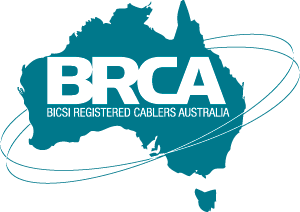-
All cablers must provide a compliance declaration form (a job sign-off form) to the customer. This form is also known as a Telecommunications customer cabling compliance form (TCA1 form).
At the end of each cabling job, you must complete the form and give a copy to the customer and employer (if appropriate). It must be completed and signed to indicate that the cabling work complies with the Wiring Rules. A copy of the completed TCA1 form must also be kept by you for at least 12 months and made available to ACMA inspectors and auditors on request. You may make arrangements with your employer to keep TCA1 forms on your behalf but the forms are your responsibility.
The TCA1 form is available to download free from the BRCA website under “Forms”.
You can use the form exactly as it is at the moment or you can incorporate the information into your existing invoice or other business forms to avoid additional paperwork. If you do this, then you must include the following statement on your paperwork: “I hereby certify that the cabling work described in this advice complies with the Wiring Rules (AS/CA S009:2020) or its replacement.”
Use of the TCA1 form or its equivalent is not required for the following activities:
- running, transposing, removing jumpers on distribution frames
- marking, replacing and upgrading cabling records
- all testing and transmission measurement activities and
- replacement of sockets or other minor cabling equipment for maintenance purposes.
-
Cable and cabling product is approved if it has an A-tick symbol on it (or on its packaging) or it is listed on the Certified Components List.
-
If 30 days or less has elapsed since your cabling registration expired, you may renew your registration without any additional requirements. If more than thirty days have lapsed, you should contact the BRCA office to discuss your circumstances with our staff, who will suggest the appropriate action to take. If considerable time has lapsed since expiration, you may have to approach the ACMA to request special clearance to re-register without further training or assessment of qualifications, however the BRCA staff will advise you if this is necessary or not.
With an expired registration, you cannot use it as evidence that you are competent for the purposes of registration. If you have a certificate from an approved course, you can use that as evidence of competence and register. If you don’t have formal training, you need to contact your Industry Training Advisory Body (ITAB) to organise a Recognition of Prior Learning (RPL) assessment before registering.
-
No. As of 1st July 2014, it is mandatory to have competency in that specialist cabling.
-
Under the registration system there are three types of registrations available – Open, Restricted and Lift. You should obtain the type of registration that is most relevant for the work that you are wish to perform.
If you wish to work in both commercial and domestic premises you will require an Open registration. However, if you only want to work in domestic premises you will require a Restricted registration.
The following is a summary of the type of work you can do under each registration. For full details, please refer to the Telecommunications Cabling Provider Rules 2014.
Open – This registration allows a cabler to undertake all types of cabling work from simple cabling in homes to complex structured cabling in multi-storey buildings.
Restricted – This registration restricts the cabler to doing work where the network boundary is a simple socket or a network termination device – typically found in domestic homes and small businesses, not in large commercial buildings. Cablers may also undertake work in multi-storey and campus-style premises where cabling is performed behind a compliant device (eg. alarm panel or modem).
Lift – This registration type is for connecting telephone cables in lifts.
-
If you are a resident or non-resident who has overseas technical, vocational or trade qualifications you may be able to obtain cabling registration in Australia provided that your overseas qualifications are assessed first. There are a number of agencies within Australia that can assess overseas qualifications in the technical, vocational and trade areas.
-
You must fill out and sign a Telecommunications customer cabling compliance form (TCA1 form) for every completed job. Ensure you:
- Clearly describe the work you’ve done – type of work, where it was located etc
- Complete all sections using a black pen
- Retain a copy of the completed TCA1 form for your own records for at least 12 months or give it to your employer for safekeeping.
- Provide the completed TCA1 to the customer
-
You don’t have to complete a TCA1 form in the following situations (although if you can if you wish):
- Testing transmission measurement activities
- Replacing sockets, detectors or other minor cabling products (excluding cable) for maintenance
- Marking, replacing and upgrading cabling records
- Running, transposing and removing jumpers on distribution frames
- You can download TCA1 forms from BRCA forms page.
-
If you’ve been working in the cabling industry for a number of years you may be able to obtain part of your registration via RPL which is the recognition through assessment of competencies held and acquired through prior learning, formal training, work experience or life experience.
-
In October 2000 Australian Communications Authority (ACMA) introduced new Cabling Provider Rules (CPRs) that replace the former system of licensing. As they expire, AUSTEL and ACMA cabling licences are phased out and replaced by Industry Registration. Though previously exempt, cablers in the Security, Fire and Data sectors are now required to hold a CPR Registration.
If you are not registered and your work is not directly and constantly supervised, you are undertaking illegal work. If your work is subject to a random inspection, penalties of over $10,000 may apply.
